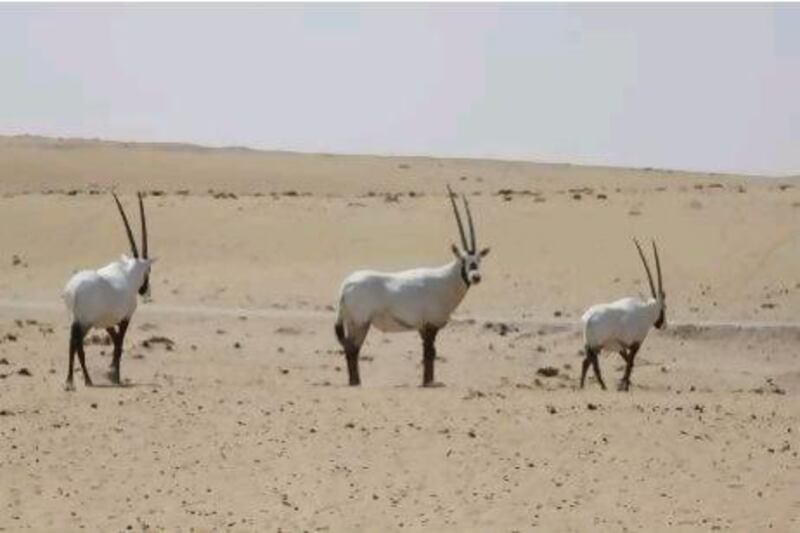DUBAI // Forty years after the Arabian oryx became extinct in the wild, the species is again roaming freely in the emirate's deserts after they were released by the Royals.
Wildlife enthusiast Ajmal Hasan has seen oryx on a number of occasions, and on Saturday he photographed some of the animals behind the Bab Al Shams desert resort.
Dr Reza Khan, Dubai Municipality's wildlife and zoo specialist, said he had seen many herds in the same area, some with as many as 50 animals.
"The Rulers have bred these in captivity and made a soft release by opening the fence in which these were originally bred," said Dr Khan.
He said the fact that oryx were running free once again was "something great and unexpected". But Dr Khan said it was unlikely they would be able to breed in the wild without support.
"They will still need some support from the management authorities as at present the desert is too harsh and the rain fails for years on end," he added.
Several wildlife collections in Dubai contain oryx, which disappeared because of over-hunting but were saved by captive-breeding programmes. They are normally kept in fenced-in, protected areas.
The animals seen by the Sharjah resident Mr Hasan, who makes regular desert trips to photograph wildlife, were in an area that was not secured by guards, gates and fences.
"We saw 10 individual oryx on Saturday," he said. "We went there pre-sunlight and we were there for four or five hours, and we saw them more after 9am.
"I was very happy to see them out there. They are wonderful animals. I felt excited when I saw them. The area is very accessible. Anyone can go there.
"There are some camel farms, I believe, in that area but we didn't see any camels. I hope there aren't any because camels are notorious feeders and the oryx would have to compete with them for food, and that would be tough."
Mr Hasan normally travels into the desert on foot, but on this occasion he was with a friend in a car. He said it would not be safe to walk near oryx.
"If I'm on foot I'm at potential risk," he said. "If there is male there with his harem he can charge, and you've seen those horns, they could do a lot of damage."
The spot where they were seen is close to a private conservation reserve where large breeding herds of oryx with many calves are kept in areas not accessible to the public.
The animals are protected by wildlife wardens and are provided with feeding stations.
There have been sightings of oryx in other areas and it is believed some have escaped from wildlife centres and reserves.
"Some of these oryx are pretty sturdy and they can jump fences, especially in areas where the sand gets high because of the wind," added Mr Hasan. "I've seen them in pristine desert in Sharjah on the other side of the fence from the Dubai Desert Conservation Reserve, and in certain other areas.
"We also saw other mammals on Saturday, the mountain gazelle and the sand gazelle. There are a good number of those out there. Most of them were wary of us but not scared that we were there, so they've obviously seen a lot of humans."
Oryx have been reintroduced into the wild with varying levels of success in Oman, where the population was devastated by poachers, and Saudi Arabia.
Animals have been released in semi-wild parts of Abu Dhabi, and the Dubai Desert Conservation Reserve and Abu Dhabi's Sir Bani Yas Island have thriving herds.
Last June the oryx's threat level was downgraded from "endangered" to "vulnerable" in the red list published by the International Union for Conservation of Nature - the first time this had happened to a species declared extinct in the wild.






